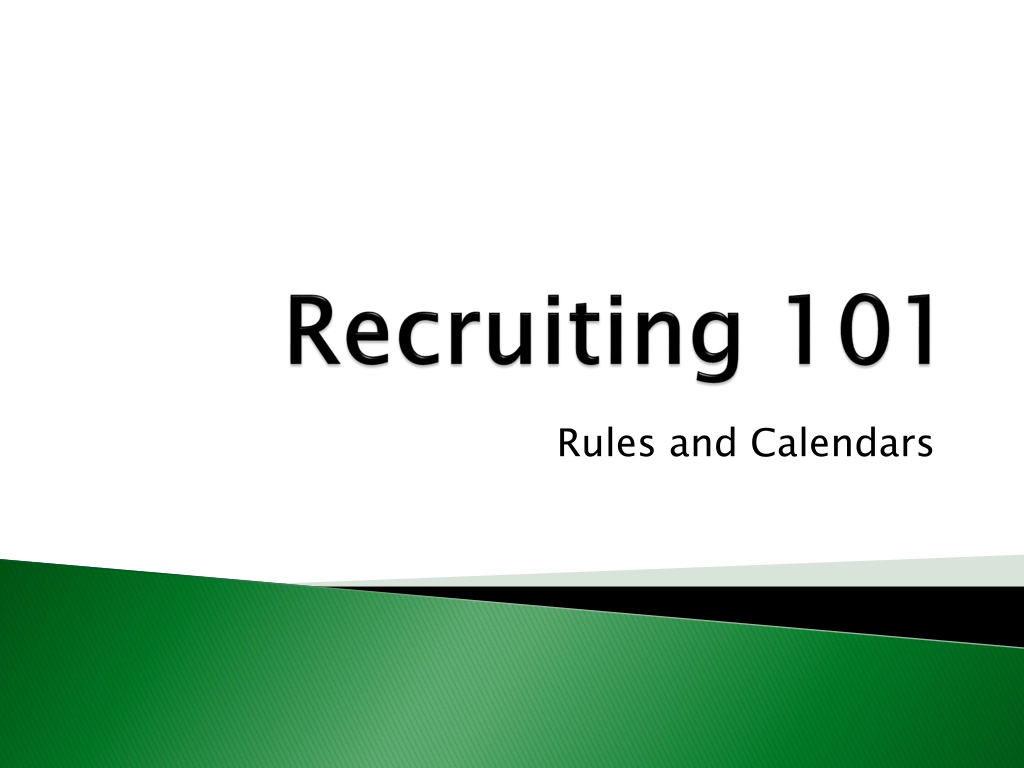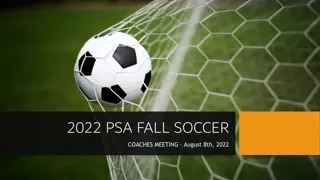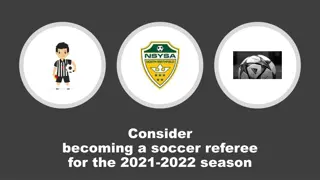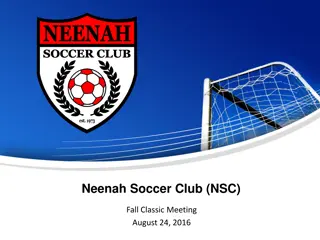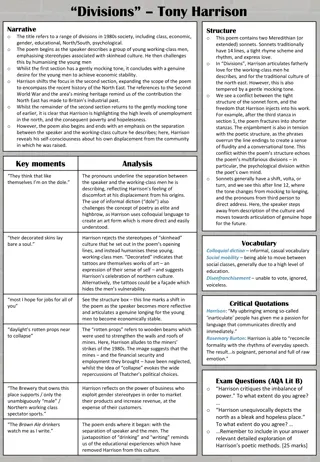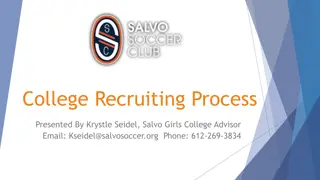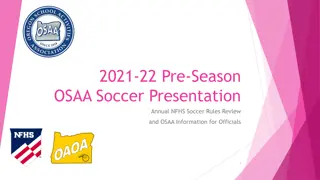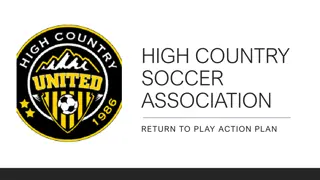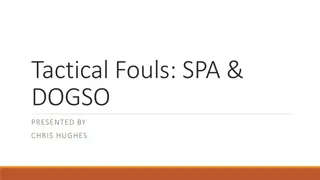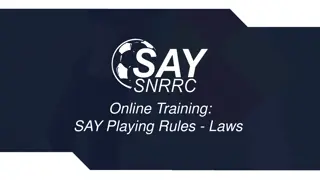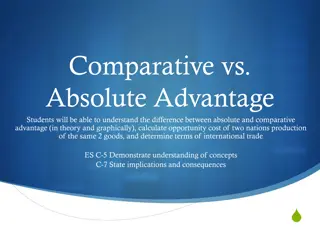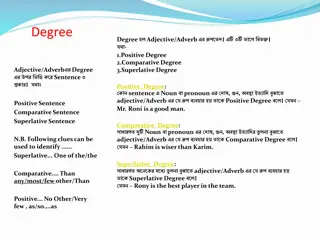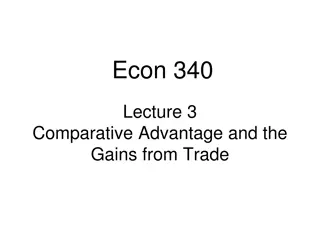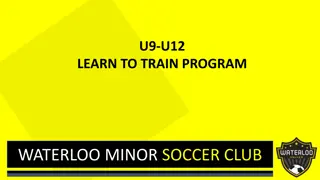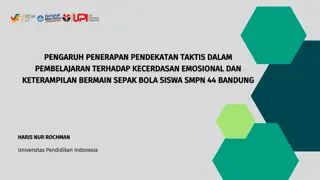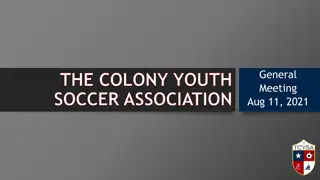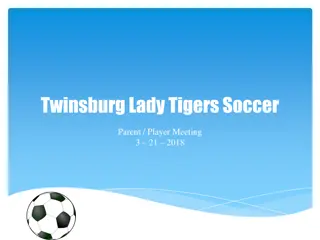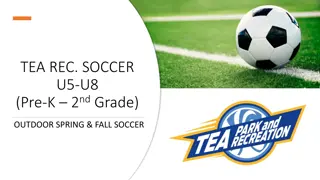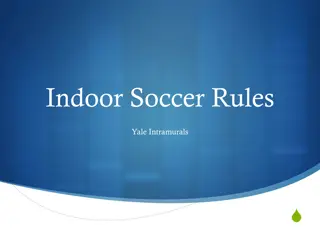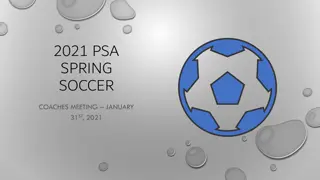Understanding Different College Soccer Divisions - A Comparative Overview
College soccer in the U.S. is governed by various bodies such as NCAA, NAIA, NJCAA, USCAA, and NCCAA. D1 colleges offer intense competition and strong athletic programs, D2 provides a balance of athletics and academics, and D3 offers flexibility and focus on academics without athletic scholarships. Each division caters to different priorities and goals for student-athletes.
Download Presentation

Please find below an Image/Link to download the presentation.
The content on the website is provided AS IS for your information and personal use only. It may not be sold, licensed, or shared on other websites without obtaining consent from the author. Download presentation by click this link. If you encounter any issues during the download, it is possible that the publisher has removed the file from their server.
E N D
Presentation Transcript
NCAA National Collegiate Athletic Association NAIA National Association of Intercollegiate Athletics NJCAA National Junior College Athletic Association USCAA United States Collegiate Athletic Association NCCAA National Christian College Athletic Association
So what are the differences between the different governing bodies?
D1 soccer colleges are known for their competitive teams and athletic rigor. For many student-athletes, the allure of competing at the D1 level lies in wanting to play against the best athletes. While there are tremendous athletes at every level, D1 college soccer teams will have the deepest bench, and the average level of competition will usually be higher than the other division levels. They tend to have larger athletic budgets and can often spend more money on their sports teams. At the D1 level, student-athletes will likely be on a large campus with thousands of other students. On D1 college soccer teams, athletes are often very serious competitors in which players were likely the best athletes on their club and high school teams. They ll be competing and practicing year-round.
As a D2 student-athlete, one will find similar athletic talent as the D1 level with more balance of expectations related to athletics, academics and a social life. D2 soccer colleges have teams that are nearly as competitive as D1 but without some of the demands of a D1 schedule. They tend to have more time to spend on academics or other extracurricular activities. Athletes are more likely to see playing time in their sophomore or even freshman year. Many D1-caliber athletes will opt to play on a D2 college soccer team so that they can get playing time earlier on in their collegiate career. At the D2 level, there are campuses that are both big and small, so it gives more options when choosing a school. Student-athletes looking for a competitive soccer program with a more relaxed environment that allows athletes time for other interests might find their best fit at the D2 level.
D3 is actually the NCAAs largest division. Of all the NCAA divisions, D3 provides the most flexibility for their student- athletes. While D3 soccer programs don t offer athletic scholarships, they have plenty of other scholarship opportunities students can take advantage of as long as they have the grades and the talent to back it up. D3 soccer teams have the most flexibility in their schedules. While athletes will still have a rigorous schedule during the season, they ll have more freedom outside of the season to pursue other interests. Many schools at the D3 level are extremely competitive academically. By playing on a D3 college soccer team, student- athletes have the opportunity to really excel athletically and academically. For well-rounded student-athletes, who want to make the most of their college experience, attending a D3 school might be the best option.
For many student-athletes, the charm of NAIA soccer colleges comes from their smaller class sizes and overall flexibility between athletics, academics and a social life. NAIA schools tend to have smaller campuses and class sizes, which is more conducive to student-athletes getting to know their professors and other students in classes. This can create be a strong sense of community. The NAIA leaves recruiting up to the colleges there s no recruiting calendars or rules to memorize. Coaches at NAIA soccer schools can recruit at any time and by any means they see fit. NAIA schools can be a good option for athletes who bloomed later or started their recruiting process late. NAIA colleges are known for their ability to accommodate all of a student-athletes interests. NAIA schools offer student-athletes the opportunity to be just that: students and athletes. While they ll be expected to train hard and play harder, they can take advantage of the other activities college has to offer.
Often, soccer players opt to compete on a junior college team in order to develop athletically and academically while saving money. Simply put, junior colleges offer a tremendous value. The average published yearly tuition and fees for a public two-year junior college (for in-district students) is around $3,440. Meanwhile, a private four- year college costs around $32,410 annually. For many athletes, junior college gives them an opportunity to improve their GPA and complete some general education requirements. Junior college is a great way to keep playing competitive soccer while figuring out questions related to academics. Competing at a junior college gives athletes an opportunity to get two more years of experience playing against college-level athletes, which can help them prepare for the rigors of collegiate soccer. By playing on a junior college soccer team, student-athletes can show coaches at other division levels that they re dedicated to playing their sport and are able to maintain the difficult schedule of a college athlete.
The United States Collegiate Athletic Association (USCAA) is a national organization that exists to provide quality athletic competition on a regional and national level. The USCAA focuses specifically on smaller institutions of higher learning and their student-athletes. The association believes that all athletes and programs deserve the same national opportunities as larger institutions. There are two divisions within the USCAA for both men and women s soccer Division I shall consist of colleges that give athletic grants/scholarships and/or are dual affiliated with the NCAA/NAIA or choose to be Division I. Division II colleges shall grant no athletic scholarship to any student-athletes and shall not grant any special financial aid or scholarships to student-athletes unless offered equally to other members of the student body Some members of the USCAA are dual affiliated and therefore are also members of other associations (ie NAIA, NCAA, etc). Any schools that are affiliated with other associations are bound by those associations regulations
The NCCAA is an association of Christ-centered collegiate institutions whose mission is to use athletic competition as an integral component of education, evangelism, and encouragement. They serve their members by setting association standards, developing communication resources, providing regional/national competition, and partnering in outreach to our communities and the world. They are committed to equipping student-athletes and coaches to make a positive impact for Christ. Most members of the NCCAA are dual affiliated and therefore are also members of other associations (ie NAIA, NCAA, etc). Any NCCAA schools that are affiliated with other associations are bound by those associations regulations. There are two divisions within the NCCAA for both men s and women s soccer. Division I programs can offer full or partial athletic scholarships. Division II can t offer athletic scholarships or special financial aid UNLESS it is offered equally to all other members of the student body.
June 15 after sophomore year Coaches can start extending verbal offers. Coaches can begin sending athletes all forms of private electronic correspondence, including text messages, instant messages, direct messages and emails, as well as all recruiting materials. Coaches can start calling athletes at this point. Coaches can also start conducting off-campus contact with athletes at their home or school. Additionally, coaches can begin initiating communication with athletes during camps and clinics about recruitment. August 1 before junior year Athletes may begin taking official or unofficial campus visits. June 15 after sophomore year August 1 before junior year:
The NCAA recruiting rules for Division 2 schools are slightly more relaxed than those for Division 1. June 15 after sophomore year Coaches may begin calling athletes, as well as send emails, texts and messages. Coaches can conduct off-campus communications with athletes and/or their parents. Athletes may start taking official or unofficial visits. Additionally, coaches can begin initiating communication with athletes during camps and clinics. June 15 after sophomore year
D3 soccer colleges have the most relaxed recruiting rules among NCAA division levels: Recruiting materials Athletes can receive recruiting materials at any time. Telephone calls There is no limit on when college coaches can call athletes. Off After the athlete s sophomore year, college coaches may begin to conduct off-campus communications. Official visits Athletes can begin taking official visits after January 1 their junior year. Recruiting materials Telephone calls Off- -campus contact campus contact Official visits January 1 of
Recruiting materials Athletes can receive recruiting materials at any time. Telephone calls There is no limit on when college coaches can call athletes. Off There is no limit on when college coaches can have off-campus contact. Official visits Based on each institutions internal policies. Recruiting materials Telephone calls Off- -campus contact campus contact Official visits
At the national level, the NJCAA sets the basic outline of what is allowed and not allowed, but those rules are the lowest common denominator for any Junior College. All junior colleges are subdivided by 24 regions around the country. Each region is free to make up its own set of rules, never lower in criteria to the criteria of NJCAA of course. The basic NJCAA rules are summaries and avoid the minute detail found in the NCAA rulebook. Because of this, many regions lend towards a strict interpretation. The NJCAA does not address contact rules for each region on their website. So your best bet is to call the school of interest and ask the coach directly what the recruiting rules are.
At the national level, the USCAA and NCCAA only set a few overall recruiting rules. The student-athletes should be protected in maintaining normal academic progress while still in high school or junior college. Recruitment should be coordinated with the overall policies that affect enrollment of new students of the institution. No official visits (no reimbursement for visits) No visits of prospective student-athletes shall involve loss of school time for them except where visitation occurs as part of a normal visitation program of the college and is approved by administration of both the college and the visiting prospective student athlete's institution.
While student-athletes and college coaches cannot communicate via email, phone or text until June 15 after (NCAA D1 and D2), coaches can begin looking at athletes much earlier. Even if coaches can t contact those recruits, they are going to look at a student-athlete s video and grades, and potentially reach out to their club and/or high school coaches to make sure the student-athlete is someone they want to recruit. Make sure your profile is always up to date with your latest videos and transcripts. Update it regularly so coaches can see your progress. June 15 after the athlete s sophomore year
One of the most important dates for an athlete to remember is June 15 after this date, any off-campus communication between a coach and a recruit is prohibited D1/D2 level). Before that, club or high school coaches will play a key role in how a college coach can contact an athlete. While club or high school coaches can relay information between the athlete and college coach, these conversations cannot be related to recruiting. College coaches can only express interest in an athlete. College coaches also use camps and clinics as an opportunity to evaluate prospective recruits. However, college coaches and athletes may only communicate related to recruitment at camps after June 15 following the athlete s sophomore year. after their sophomore year. Before prohibited according to NCAA rules (at the
Dead periods DEFINITION: Coaches may not have any in-person contact with recruits and/or their parents. Athletes and coaches are still allowed to communicate via phone, email, social media and other digital communication channels. DEAD PERIOD DATES: Nov. 11 signing of the National Letter of Intent) Dec. 13 NCAA Division I Men s Soccer Championship; a coaching staff member may attend an event conducted in conjunction with the host city of the championship) Dec. 15 day of the week those dates fall on) Contact period DEFINITION: Contact can be made anytime outside of the above dead periods, and a quiet period (only on campus contact) between December 23-25, 2019 (for Men s soccer). Communication between athletes and coaches is fair game throughout the rest of the year. Dead periods: Nov. 11- -14, 2019 14, 2019 (Monday through Thursday of the initial week for Dec. 13- -15, 2019 15, 2019 Men s College Soccer (Friday through Sunday of the Dec. 15- - Jan 5 Contact period: Jan 5 Women s College Soccer (every year, no matter what
Dead periods DEFINITION: Coaches may not have any in-person contact with recruits and/or their parents. Athletes and coaches are still allowed to communicate via phone, email, social media and other digital communication channels. DEAD PERIOD DATES: Nov. 11 initial week for signing of the National Letter of Intent) Dead periods Nov. 11- -14, 2019 14, 2019 (Monday through Thursday of the
For D3 schools, there are no dead periods. The contact period is effectively year-round.
For NAIA, there are no dead periods. The contact period is effectively year-round.
For NJCAA, there are no specified dead periods unless the region in which the junior college belongs declares one. The contact period is effectively year-round.
No official dead periods. However the USCAA or NCCAA does not allow any visits of prospective student-athletes if it involves loss of school time for them except where visitation occurs as part of a normal visitation program of the college and is approved by administration of both the college and the visiting prospective student athlete's institution.
Official Visits A visit in which the school pays all expenses for the student-athlete to visit the college. Each student-athlete is limited to 5 total official visits and only 1 per school. Unofficial Visits Any visit in which the college does not pay for the student to visit. An unlimited number of unofficial visit are allowed after the specified date based on the division. Campus Visits (outside of soccer) Prior to the specified date, students are allowed to visit a campus and take campus tour as many times as they wish as long as there is no contact with college coaches or athletic staff. Official Visits Unofficial Visits Campus Visits (outside of soccer)
Max Max Number of Teams Number of Teams Average Roster Size Average Roster Size Division Level Division Level Scholarships Per School Scholarships Per School D1 D1 333 28 14 D2 D2 265 27 9.9 D3 D3 441 25 N/A NAIA NAIA 188 25 12 NJCAA NJCAA 181 19 18 USCAA D1 USCAA D1 16 USCAA D2 USCAA D2 29 N/A NCCAA D1 NCCAA D1 45 NCCAA D2 NCCAA D2 12 N/A
Max Max Number of Schools Number of Schools Average Roster Size Average Roster Size Division Level Division Level Scholarships per School Scholarships per School D1 D1 205 29 9.9 D2 D2 214 31 9 D3 D3 415 29 N/A NAIA NAIA 188 30 12 NJCAA NJCAA 217 19 18 USCAA D1 USCAA D1 16 USCAA D2 USCAA D2 39 N/A NCCAA D1 NCCAA D1 46 NCCAA D2 NCCAA D2 25 N/A
